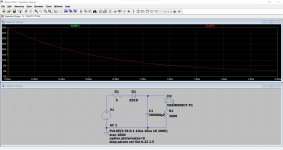Hi,
Building this DC power supply, ~36v out.
I’d like to add a bleed resistor and LED for discharging the cap banks if they unloaded, what spec do I need?
Would be great to know how to calculate it for future projects too, thanks.

Building this DC power supply, ~36v out.
I’d like to add a bleed resistor and LED for discharging the cap banks if they unloaded, what spec do I need?
Would be great to know how to calculate it for future projects too, thanks.
Last edited:
The LED limits your choice. A not so bright (as in a low efficiency LED) could be run at 10 milliamps. So rough and ready that is about 3600 ohm. So a 3.9k would be fine at 0.5 watt or higher rating.
Calculate as R =V/I so 36/0.01 = 3600 ohm
The voltage on the capacitor will fall exponentially and you have a LOT of capacitance there.
https://www.schoolphysics.co.uk/age...ge decay): V = V o,decay): Q = Q o e - (t/RC)
It would take over 30 minutes to reach about 4 volts with an LED in circuit. You could always use a second resistor across the rail to speed it up but if you go to low you waste power and generate heat.
This shows how it would look. Voltage on the left scale and time along the bottom. 2ks is 2000 seconds 😱

Calculate as R =V/I so 36/0.01 = 3600 ohm
The voltage on the capacitor will fall exponentially and you have a LOT of capacitance there.
https://www.schoolphysics.co.uk/age...ge decay): V = V o,decay): Q = Q o e - (t/RC)
It would take over 30 minutes to reach about 4 volts with an LED in circuit. You could always use a second resistor across the rail to speed it up but if you go to low you waste power and generate heat.
This shows how it would look. Voltage on the left scale and time along the bottom. 2ks is 2000 seconds 😱

^ Great reply. But 36Vdc isn't going to bite hard.
I'd suggest , as above, at least two resistors - one R+LED in series to give you a useful indicator, R value 3k3-10k depending on how bright you want the LED;
A second R value , maybe 1W rated minimum of say 2k2 to 3k3 across the caps in the middle of the string to ensure it gets pulled down to 0v eventually.
In practivce - if that is for a pre or power amplifier - the standing quiescent / idle bias current will draw the voltage down fast at switch-off; the resistor merely finishes the process.
I'd suggest , as above, at least two resistors - one R+LED in series to give you a useful indicator, R value 3k3-10k depending on how bright you want the LED;
A second R value , maybe 1W rated minimum of say 2k2 to 3k3 across the caps in the middle of the string to ensure it gets pulled down to 0v eventually.
In practivce - if that is for a pre or power amplifier - the standing quiescent / idle bias current will draw the voltage down fast at switch-off; the resistor merely finishes the process.
Thanks guys 🙏 that’s Crystal Clear 👍
30mins to discharge, will a discharge pen/tool do it quicker? As you say, it’s a lot of capacitance.
Any recommendations?
30mins to discharge, will a discharge pen/tool do it quicker? As you say, it’s a lot of capacitance.
Any recommendations?
Oh definitely, I’ll be interesting to hear what it sounds like.That power supply is WAY overdone with capacitance.
you'll have about 130 Joules to dissipate in total; so sure, use something like a min 5w, better 10w /50ohm resistor, a wire-wound type for preference.Thanks guys 🙏 that’s Crystal Clear 👍
30mins to discharge, will a discharge pen/tool do it quicker? As you say, it’s a lot of capacitance.
Any recommendations?
Peak current under an amp; energy substantially dumped in around 10s. though the tail will be longer - but the risk is gone fast.. And no great spark.
What leads to such massive C values - and the idea of a discharge tool? It might be easier to come up with a circuit that detects loss of AC, and then shorts the cap bank through closing a 5A+ relay via a small-value, high-power resistor - if you have the need.
Nice idea for the circuit, would help in disconnecting the power supply or avoiding a short during re-attachment if there’s still power in the caps. This is what I’m working on:
https://audiophilestyle.com/forums/topic/64732-building-an-unregulated-linear-power-supply/
https://audiophilestyle.com/forums/topic/64732-building-an-unregulated-linear-power-supply/
0.1 Farad at 36V will melt your wedding ring to your finger-bone. Or other small metallic object or body-part.36Vdc isn't going to bite hard.
Professionally "we know better" and work without jewelry. But a forum 90% amateurs is different.
I noted c 130 joules; so yes - That's a lot of energy as you make plain. (my comment was originally from POV that the voltage isn't going to bite hard - it's under the SELV limit.)
Thank you for the practical reminder of huge damage potential.
Thank you for the practical reminder of huge damage potential.
- Home
- Amplifiers
- Power Supplies
- Bleed resistor / LED